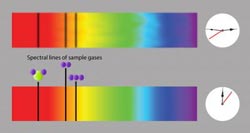Innovation in spectroscopy could improve greenhouse gas detection

Fast, accurate spectroscopy scans of the atmosphere across a wide range of light frequencies could improve the performance of greenhouse gas measurement devices. This artist's conception compares current technology, which functions slowly and unevenly, with the NIST team's improvement, which changes the scanning laser's frequency evenly and more than 1,000 times faster, permitting full-spectrum scans within a few milliseconds.<br><br>Credit: Talbott, Gerskovic/NIST<br>
The team, which recently published its findings in the journal Nature Photonics, says the technique also could work for other jobs that require gas detection, including the search for hidden explosives and monitoring chemical processes in industry and the environment.
Searching for faint whiffs of an unusual gas mixed in the air is called “trace gas sensing.” By far, the most common method is spectroscopy—identifying gas molecules by the unique set of frequencies of light that each absorbs. The telltale pattern of dark lines in a spectrum indicates which gases are present in the mix. Accurately measuring the concentrations of relatively low-concentration gases, however, requires a lot of light, generated by a laser that can be tuned to different colors. Until now, tuning a laser to shine in a wide enough range of colors typically has required a mechanical device to change the frequency, but all the available methods adjust the laser too slowly to obtain meaningful snapshots of the turbulent atmosphere.
“One of the major goals in climate science is to combine a wide variety of high-accuracy atmospheric measurements, including ground-based, aircraft and satellite missions, in order to fully understand the carbon cycle,” says the research team's David Long, a scientist in NIST's Chemical Sciences Division. “The technology we've developed is general enough to be applicable for each of these platforms. The high speed of the technique allows for very accurate measurements of atmospheric gases at rates which are faster than atmospheric changes in temperature and pressure due to turbulence.”
The team found a solution using electronics that permit fast and discrete changes in frequency. The components—called an electro-optic modulator and an optical resonator—work together to alter the laser so that its light shines in a number of different frequencies, and then to filter these frequencies so that the laser only shines in one color at any given instant. The new method allows a wide range of different frequencies to pass through a gas sample in a few milliseconds or less, with the added benefit of providing a clearer and more accurate resulting spectrum than the previous “slow scan” methods could.
Long says that the Nature Photonics paper details the use of the technique in a controlled laboratory environment using a small sample chamber for ground-based measurements, but that the team has submitted other papers with data indicating the technique also could work at great distances—potentially allowing a scanner to be mounted on a vehicle, an aircraft or a satellite. The team also has applied for a patent on its work, he says.
*G.-W. Truong, K.O. Douglass, S.E. Maxwell, R.D. van Zee, D.F. Plusquellic, J.T. Hodges and D.A. Long. Frequency-agile, rapid scanning spectroscopy. Nature Photonics, DOI: 10.1038/NPHOTON.2013.98, April 28, 2013.
Media Contact
More Information:
http://www.nist.govAll latest news from the category: Earth Sciences
Earth Sciences (also referred to as Geosciences), which deals with basic issues surrounding our planet, plays a vital role in the area of energy and raw materials supply.
Earth Sciences comprises subjects such as geology, geography, geological informatics, paleontology, mineralogy, petrography, crystallography, geophysics, geodesy, glaciology, cartography, photogrammetry, meteorology and seismology, early-warning systems, earthquake research and polar research.
Newest articles

Superradiant atoms could push the boundaries of how precisely time can be measured
Superradiant atoms can help us measure time more precisely than ever. In a new study, researchers from the University of Copenhagen present a new method for measuring the time interval,…

Ion thermoelectric conversion devices for near room temperature
The electrode sheet of the thermoelectric device consists of ionic hydrogel, which is sandwiched between the electrodes to form, and the Prussian blue on the electrode undergoes a redox reaction…

Zap Energy achieves 37-million-degree temperatures in a compact device
New publication reports record electron temperatures for a small-scale, sheared-flow-stabilized Z-pinch fusion device. In the nine decades since humans first produced fusion reactions, only a few fusion technologies have demonstrated…





















